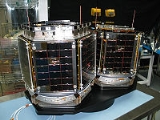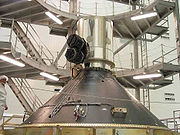
3 Corner Satellite
Encyclopedia
Three Corner Satellite consists of three student-built microsatellites flying in formation. Primary mission objectives were to demonstrate formation flying, provide stereoscopic imaging of cloud formations, and demonstrate distributed and autonomous operations.
A pair of spacecraft, Ralphie
and Sparky, was developed by the University of Colorado at Boulder
and Arizona State University
as part of the Air Force Research Laboratory's
University Nanosat Program. A third satellite, Petey
, developed by New Mexico State University
was originally also part of the 3CS but was not completed in time for launch.
The 3CS stack was originally slated for launch aboard the Space Shuttle
in 2003, but after Shuttle Columbia tragedy
, mission organizers switched to Boeing Delta IV Heavy rocket (it was its first launch). Due to a problem with the rocket during launch, 3CS failed to achieve orbit. Satellites were to have been dropped off at a low 180 km × 240 km, but they entered orbit at a height of only 105 km, which led to a rapid decay
.

Secondary mission objectives:
A pair of spacecraft, Ralphie
Ralphie (satellite)
Ralphie is a satellite, part of Three Corner Satellite project. Designed and being built by mostly undergraduate students at the University of Colorado at Boulder as part of the Air Force Research Laboratory's University Nanosat Program....
and Sparky, was developed by the University of Colorado at Boulder
University of Colorado at Boulder
The University of Colorado Boulder is a public research university located in Boulder, Colorado...
and Arizona State University
Arizona State University
Arizona State University is a public research university located in the Phoenix Metropolitan Area of the State of Arizona...
as part of the Air Force Research Laboratory's
Air Force Research Laboratory
The Air Force Research Laboratory is a scientific research organization operated by the United States Air Force Materiel Command dedicated to leading the discovery, development, and integration of affordable aerospace warfighting technologies; planning and executing the Air Force science and...
University Nanosat Program. A third satellite, Petey
Petey (satellite)
Petey is a satellite, part of Three Corner Satellite project. Designed and being built by mostly undergraduate students at the New Mexico State University as part of the Air Force Research Laboratory's University Nanosat Program...
, developed by New Mexico State University
New Mexico State University
New Mexico State University at Las Cruces , is a major land-grant university in Las Cruces, New Mexico, United States...
was originally also part of the 3CS but was not completed in time for launch.
The 3CS stack was originally slated for launch aboard the Space Shuttle
Space Shuttle
The Space Shuttle was a manned orbital rocket and spacecraft system operated by NASA on 135 missions from 1981 to 2011. The system combined rocket launch, orbital spacecraft, and re-entry spaceplane with modular add-ons...
in 2003, but after Shuttle Columbia tragedy
Space Shuttle Columbia disaster
The Space Shuttle Columbia disaster occurred on February 1, 2003, when shortly before it was scheduled to conclude its 28th mission, STS-107, the Space Shuttle Columbia disintegrated over Texas and Louisiana during re-entry into the Earth's atmosphere, resulting in the death of all seven crew members...
, mission organizers switched to Boeing Delta IV Heavy rocket (it was its first launch). Due to a problem with the rocket during launch, 3CS failed to achieve orbit. Satellites were to have been dropped off at a low 180 km × 240 km, but they entered orbit at a height of only 105 km, which led to a rapid decay
Orbital decay
Orbital decay is the process of prolonged reduction in the altitude of a satellite's orbit.This can be due to drag produced by an atmosphere due to frequent collisions between the satellite and surrounding air molecules. The drag experienced by the object is larger in the case of increased solar...
.

Porject's mission
Primary mission objectives:- stereoscopic imaging of cloudCloudA cloud is a visible mass of liquid droplets or frozen crystals made of water and/or various chemicals suspended in the atmosphere above the surface of a planetary body. They are also known as aerosols. Clouds in Earth's atmosphere are studied in the cloud physics branch of meteorology...
s and other atmosphericAtmosphereAn atmosphere is a layer of gases that may surround a material body of sufficient mass, and that is held in place by the gravity of the body. An atmosphere may be retained for a longer duration, if the gravity is high and the atmosphere's temperature is low...
structures - formation flying - the satellites will operate as a network to synchronize targeting and data acquisitionData acquisitionData acquisition is the process of sampling signals that measure real world physical conditions and converting the resulting samples into digital numeric values that can be manipulated by a computer. Data acquisition systems typically convert analog waveforms into digital values for processing...
and to relay health and status information among the satellites in the constellationSatellite constellationA group of artificial satellites working in concert is known as a satellite constellation. Such a constellation can be considered to be a number of satellites with coordinated ground coverage, operating together under shared control, synchronised so that they overlap well in coverage and... - End-to-End Data Systems (EEDS) will support automated operations, react to unplanned faults and opportunities, and to optimize operations and data handling
Secondary mission objectives:
- demonstrate micropropulsion, by increasing the satellites' altitude to extend mission lifetime and improve data gathering capacity
- demonstrate a modular spacecraft bus design
- emphasize student education by allowing students to actively participate in program
Links
- http://ase.jpl.nasa.gov/public/projects/3cs/
- http://spacegrant.colorado.edu/3cs/

